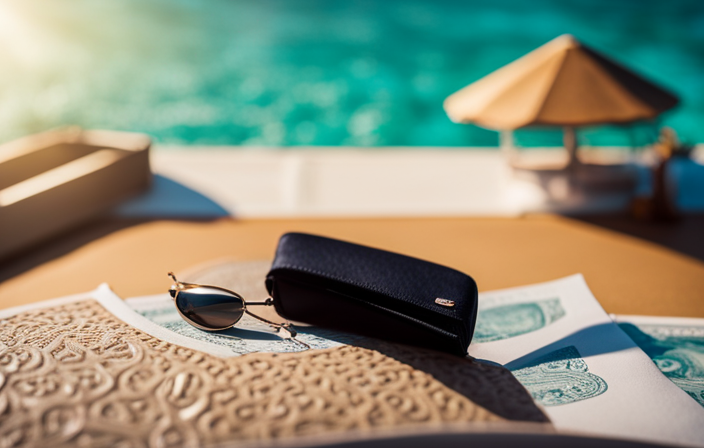Oh, the immense sea, the gentle sway of the ship, and the excitement of embarking on an adventure. Setting sail on a cruise is a dream for many, yet there’s still the important question, ‘How much money should I carry?’
As someone who loves to set sail and explore new horizons, I’ve learned a thing or two about budgeting for a cruise. In this article, we’ll dive deep into the world of cruise expenses and help you navigate the murky waters of financial planning.
From understanding your expenses to keeping track of your spending, we’ll cover it all.
So, sit back, relax, and let’s chart a course to financial success on your next cruise adventure.
Key Takeaways
- Set a realistic budget and allocate funds for various expenses such as meals, drinks, excursions, and shopping.
- Research currency and payment options at cruise destinations to avoid unnecessary fees and inconveniences.
- Prioritize activities based on personal interests and consider free or included activities to save money.
- Consider all-inclusive packages to save money on meals, drinks, entertainment, and gratuities.
Understand Your Expenses
Before embarking on your cruise adventure, it’s important to understand your expenses and have a clear idea of how much money you’ll need. To do this, set a daily spending limit and track your expenses throughout the journey. This will help you stay on top of your spending and avoid any surprises with your overall budget.
Start by estimating how much you’ll need for meals, drinks, excursions, shopping, and any other activities you plan to participate in. Remember to take into account any expenses that may already be included in your cruise package. By understanding your expenses and setting a realistic budget, you can enjoy your cruise without the worry of overspending.
Set a Realistic Budget
To set a realistic budget for your cruise, consider factors such as your preferred activities, dining options, and shopping desires. If you plan on taking part in excursions and indulging in specialty dining experiences, allocate a higher budget to fully enjoy your cruise vacation.
Evaluate your savings and determine how much you can comfortably afford to spend on your cruise. This will give you a better understanding of your expenses. Also, manage unexpected costs that may arise during your trip, such as medical emergencies or unplanned purchases.
Research the average cost of excursions and plan accordingly. Set aside some money for souvenirs and shopping. Consider any additional expenses, such as gratuities or spa treatments. Keep a contingency fund for any unforeseen circumstances.
By understanding your savings and managing unexpected costs, you can set a realistic budget for your cruise and ensure a stress-free vacation. Remember to research currency and payment options to make the most of your trip.
Research Currency and Payment Options
When planning your cruise, it’s crucial to research the currency and payment options available at your destinations to make the most of your vacation experience. By taking the time to research the local currency and compare payment options, you can ensure that you have the right amount of money for your trip and avoid any unnecessary fees or inconveniences. To help you with this, here is a table comparing the local currency and payment options for popular cruise destinations:
| Destination | Local Currency | Accepted Payment Options |
|---|---|---|
| Caribbean | US Dollar | Credit Cards, Cash |
| Mediterranean | Euro | Credit Cards, Cash |
| Alaska | US Dollar | Credit Cards, Cash |
| Australia | Australian Dollar | Credit Cards, Cash |
By understanding the currency and payment options at your destinations, you can plan accordingly and ensure a smooth sailing vacation. Now that you know how to handle your finances, let’s move on to planning your onboard activities.
Plan Your Onboard Activities
When planning my onboard activities, I need to research the cost of optional activities such as the spa, fitness classes, and the casino. This will help me budget and decide which activities are worth the extra cost.
Additionally, I should prioritize the activities that interest me the most, so I can make the most of my time on the cruise.
Lastly, I should look for free or included activities to save money, as there are often plenty of options available that don’t require an additional fee.
By following these steps, I can plan my onboard activities in a practical and cost-effective way.
Research the cost of optional activities (spa, fitness classes, casino, etc.)
The spa, fitness classes, and casino all come with additional costs that should be factored into your budget for the cruise. It’s important to research the cost of these optional activities beforehand so that you can plan accordingly.
Spa services, such as massages and facials, can be quite expensive, so it’s a good idea to check the prices and decide which treatments are worth the splurge. Additionally, familiarize yourself with casino etiquette if you plan on trying your luck at the onboard casino.
Remember that these activities are optional and not included in the cruise fare, so it’s essential to budget accordingly. Once you have an idea of the costs, you can prioritize the activities that interest you the most and allocate your funds accordingly.
Prioritize activities that interest you the most
To make the most of your cruise experience, prioritize the activities that interest you the most and focus on indulging in those first.
For example, if you’re a fitness enthusiast, you might want to start your day with a high-energy Zumba class followed by a relaxing massage at the spa to reward yourself for your hard work. By prioritizing activities that align with your interests, you can ensure that you get the most enjoyment out of your cruise.
Additionally, when budgeting for shore excursions, consider which activities are worth the extra cost and which ones you can skip. Look for free or included onboard activities, such as live shows, cooking classes, or poolside games, to save money while still having a great time. These options allow you to have a fulfilling experience without breaking the bank.
Transitioning into the next section, let’s explore how to look for free or included activities to save money.
Look for free or included activities to save money
To save money, look for free or included activities. Here are three ways to find affordable onboard activities:
-
Consult the daily schedule: Cruise ships provide a daily schedule of activities, highlighting the complimentary ones. Take advantage of these offerings, as they are included in your fare and can provide hours of entertainment.
-
Utilize onboard facilities: Many ships offer amenities like pools, fitness centers, and sports courts that are free to use. Take advantage of these facilities to stay active and have fun without spending extra money.
-
Attend informational sessions: Cruise lines often host free informational sessions on topics such as health, wellness, and destination highlights. These sessions not only provide valuable information but also offer a chance to interact with experts and fellow passengers.
By prioritizing free or included activities, you can save money while still enjoying a variety of experiences onboard. Transitioning into the next section, considering all-inclusive packages can provide even more value for your cruise vacation.
Consider All-Inclusive Packages
Imagine yourself sailing on a magnificent cruise ship, where all your worries about money are swept away by the gentle waves of an all-inclusive package.
All-inclusive benefits can be a game-changer when it comes to saving money on a cruise. These packages typically include meals, drinks, entertainment, and sometimes even gratuities. By opting for an all-inclusive package, you can avoid the hassle of constantly budgeting for every little expense.
To make the most of this option, it is important to compare package prices from different cruise lines. Some may offer better value for money than others, so it’s worth doing your research.
Once you have secured an all-inclusive package, you can shift your focus to planning the exciting port excursions that await you. These adventures will be the cherry on top of an already amazing cruise experience.
Research Port Excursions
When it comes to planning port excursions during a cruise, I always make sure to look for affordable options at each port. By doing a little research beforehand, I can often find great deals and save some money.
Another tip I’ve learned is to book excursions in advance, as this usually results in better prices and availability.
Lastly, before making any final decisions, I always evaluate the value and interest of each excursion to make sure it aligns with my preferences and budget.
Look for affordable excursion options at each port
Consider exploring budget-friendly activities and tours available at each port to make the most of your cruise experience without breaking the bank.
Look for affordable excursion packages that the cruise line offers or research local transportation options such as buses or taxis to get to nearby attractions. By doing this, you can save money on expensive guided tours and explore the port at your own pace.
Additionally, look for free or low-cost activities like visiting local markets, parks, or beaches. These activities can provide a unique cultural experience and allow you to interact with the local community.
Remember to plan your time wisely and prioritize the activities that interest you the most. By taking advantage of these affordable options, you can enjoy your cruise while staying within your budget.
Consider booking excursions in advance for better deals and to ensure availability.
Consider booking excursions in advance for better deals
Booking excursions in advance can lead to significant savings, with some travelers reporting discounts of up to 30% on popular activities and tours. Planning ahead allows you to take advantage of early bird deals and secure your spot on the excursions you’re most interested in. By booking last minute, you run the risk of limited availability and higher prices. To help you make informed decisions, consider creating a table to compare different excursion options. In the left column, list the activities and tours available at each port, and in the right column, note the cost and duration of each excursion. This visual representation will make it easier to identify budget-friendly options that align with your interests. Evaluating the value and interest of each excursion before booking is essential to ensure you get the most out of your cruise experience.
Evaluate the value and interest of each excursion before booking
Before you make any decisions, take a moment to truly evaluate the value and interest of each excursion – you don’t want to miss out on an incredible experience!
When evaluating excursion prices, consider what is included in the cost. Some excursions may offer transportation, meals, or entrance fees, while others may only cover the activity itself. Think about what is important to you and what you’re willing to pay for.
Additionally, compare excursion options to ensure you’re getting the best deal. Look for similar excursions offered by different companies and compare their prices and reviews. Keep in mind that the cheapest option may not always be the best value.
By carefully evaluating and comparing excursion options, you can make informed decisions that will enhance your cruise experience.
Now, let’s talk about budgeting for souvenirs and shopping.
Budget for Souvenirs and Shopping
When planning my budget for souvenirs and shopping on a cruise, I start by determining how much I’m willing to spend.
I research the shopping options both on the cruise ship and at the ports to get an idea of what’s available and the prices.
Then, I set a limit for myself and prioritize the items I want to purchase, ensuring that I stay within my budget while still getting the things that are most important to me.
Determine how much you’re willing to spend on souvenirs
When determining how much you’re willing to spend on souvenirs, it’s important to set a budget. Assess your overall cruise budget and allocate a specific amount for souvenirs. Consider the cost of living in the port cities to gauge the price range of souvenirs. Prioritize the items you truly want and allocate more funds for them. Research the average price of souvenirs in advance to avoid getting ripped off. By following these budgeting tips and saving strategies, you can make informed decisions about how much money to allocate for souvenirs. Now, let’s explore how to research shopping options on the cruise ship and at ports.
Research shopping options on the cruise ship and at ports
To make the most of your shopping experience, explore the diverse range of shopping options on board and at the ports. On the cruise ship, there are duty free shops where you can find a variety of items such as jewelry, clothing, and electronics. It’s worth researching duty free prices beforehand to ensure you’re getting a good deal. At the ports, take the time to research local markets where you can find unique souvenirs and gifts. Don’t be afraid to haggle for better prices, as it’s often expected in certain countries. To help you compare prices and make informed decisions, here is a table showcasing the average prices of popular items at different shopping locations:
| Item | Cruise Ship Price ($) | Port Market Price ($) |
|---|---|---|
| Jewelry | 200 | 100 |
| Clothing | 50 | 30 |
| Electronics | 300 | 200 |
| Souvenirs | 10 | 5 |
| Local Crafts | 20 | 15 |
By researching duty free shops and local markets, you can compare prices and make better choices when it comes to shopping. Now, let’s move on to setting a limit and prioritizing the items you want to purchase.
Set a limit and prioritize the items you want to purchase
When it comes to shopping on a cruise, it’s important to set a limit and prioritize the items you want to purchase. This will help you stay within your budget and avoid overspending.
Start by researching the shopping options on the cruise ship and at ports, so you have an idea of what is available and the prices. Once you have a list of items you want to buy, rank them in order of importance. This way, if you run out of money or decide to save some for other activities, you’ll know which items are the most essential.
Additionally, it’s important to plan for emergencies and consider travel insurance. Unexpected expenses can arise, and having insurance can provide peace of mind.
As you plan your shopping budget, remember to factor in gratuities and tipping, which will be covered in the next section.
Factor in Gratuities and Tipping
When preparing my budget for a cruise, I make sure to factor in the gratuities and tipping expenses.
It is important to understand the tipping policy on the cruise ship, as this will determine how much I should budget for gratuities.
I always calculate the recommended amount for gratuities based on the guidelines provided by the cruise line. This helps me include this expense in my overall budget to ensure I have enough money set aside for tipping.
Understand the tipping policy on the cruise ship
Wow, the tipping policy on the cruise ship is absolutely outrageous, you won’t believe how much extra money you’ll need to bring! Understanding the tipping etiquette on a cruise ship is crucial to avoid any awkward situations. Here are some key points to keep in mind:
-
Tipping for different services: On a cruise ship, you’ll encounter various staff members providing exceptional service, such as room stewards, waitstaff, and bartenders. Each of these individuals should be tipped accordingly based on their level of service.
-
Automatic gratuities: Many cruise lines have started implementing automatic gratuities, which are added to your onboard account daily. These charges can quickly add up, so it’s important to budget for them.
-
Additional tipping: While automatic gratuities cover most services, it’s customary to tip extra for exceptional service or if you frequent certain bars or restaurants more often.
-
Cash or card: Most cruise lines allow you to charge gratuities to your onboard account, but it’s a good idea to carry some cash for additional tipping.
-
Research beforehand: Before your cruise, familiarize yourself with the specific tipping policy of the cruise line you’ll be sailing with.
Understanding the tipping policy on a cruise ship is just the first step. To calculate the recommended amount for gratuities, let’s move on to the next section.
Calculate the recommended amount for gratuities
When it comes to tipping on a cruise ship, understanding the recommended gratuity amount is essential. By calculating the tipping percentages and determining the tipping etiquette, you can ensure that you are appropriately compensating the hardworking staff who make your cruise experience enjoyable. To help you visualize the recommended gratuity amount, here is a table that breaks down the suggested tipping percentages for different staff members:
| Staff Member | Recommended Tipping Percentage |
|---|---|
| Wait Staff | 15-20% |
| Cabin Steward | $3-5 per day |
| Bartender | $1-2 per drink |
| Room Service | $2-5 per delivery |
| Spa Therapist | 15-20% |
By keeping these percentages in mind, you can accurately calculate the amount you should set aside for gratuities. Now that you know how to calculate the recommended amount, let’s move on to the next step and discuss how to include tipping expenses in your overall budget.
Include tipping expenses in your overall budget
Including tipping expenses in your overall budget is crucial for ensuring that you are financially prepared for the additional costs associated with gratuities on a cruise ship. Tipping etiquette varies from cruise line to cruise line, but it is generally recommended to budget around $12 to $15 per person, per day for gratuities. This may seem like a significant amount, but it is important to remember that these tips go towards supporting the hardworking staff who make your cruise experience enjoyable.
To manage tipping expenses effectively, consider the following:
-
Research the tipping policies of your specific cruise line to understand the recommended amounts and whether they are automatically added to your onboard account.
-
Plan ahead and factor in the cost of gratuities when setting your overall cruise budget.
-
Keep in mind that additional tips may be expected for exceptional service, such as from your cabin steward or dining staff.
-
Consider using cash for tipping to ensure that the tips directly reach the recipients.
By managing your tipping expenses wisely, you can avoid any unexpected financial burdens during your cruise. As you plan your budget, it is also important to keep track of your expenses to ensure you stay within your financial limits.
Keep Track of Your Expenses
To make sure you don’t overspend, it’s crucial to keep a careful eye on your expenses while on a cruise, as every penny counts. Understanding hidden expenses and tracking your daily spending are essential to staying within your budget. To help you stay organized, I recommend keeping a record of your expenses in a simple table like the one below:
| Date | Item | Cost |
|---|---|---|
| Day 1 | Cocktails | $15 |
| Day 2 | Spa treatment | $100 |
| Day 3 | Shore excursion | $50 |
By tracking your expenses in this way, you can easily identify any areas where you may be overspending and make adjustments accordingly. It’s also a good idea to set a daily spending limit and stick to it. By being mindful of your spending, you can ensure that you have enough money for unexpected contingencies. Speaking of which, it’s important to plan for contingencies during your cruise, which we will discuss in the next section.
Plan for Contingencies
Now that we’ve discussed the importance of keeping track of your expenses on a cruise, let’s move on to the next crucial aspect of budgeting: planning for contingencies.
While it’s essential to have a budget and stick to it, it’s equally important to prepare for unexpected expenses and emergencies that may arise during your trip. No one wants to be caught off guard by a sudden medical expense or a lost passport. To ensure you’re fully prepared, make sure to set aside some extra money specifically for these unexpected situations. Additionally, consider purchasing travel insurance that covers medical emergencies, trip cancellations, and lost belongings. By planning for contingencies and preparing for unexpected expenses, you can enjoy your cruise with peace of mind knowing that you’re financially protected.
-
Unexpected medical expenses: It’s always wise to have a safety net in case you or your family members need medical attention during the cruise.
-
Lost or stolen belongings: In the unfortunate event of losing valuable items or having them stolen, having extra funds can help cover the cost of replacements.
-
Trip cancellations or interruptions: Sometimes unforeseen circumstances force you to cancel or cut short your trip. Having a contingency fund will help you manage any additional expenses that may arise due to these situations.
Frequently Asked Questions
Are gratuities and tipping included in the price of an all-inclusive package?
Gratuities and tipping are not typically included in the price of an all-inclusive package on a cruise. It is customary to budget extra money for these expenses, as they are usually paid directly to the staff for their services.
What are some common contingencies that I should plan for on a cruise?
Common cruise emergencies include seasickness, lost luggage, and medical issues. To handle medical emergencies, notify the ship’s medical staff immediately. It’s important to have travel insurance that covers medical expenses and consider packing essential medications.
How much money should I budget for port excursions?
When budgeting for shore activities, it is important to consider port excursion costs. Research the activities available at each port and estimate the costs for each. Allocate a reasonable amount of money for these experiences to ensure you can fully enjoy your time ashore.
Are there any additional fees or charges that I should be aware of when using my credit card for onboard expenses?
When using a credit card for onboard expenses, it’s important to be aware of any additional fees and credit card charges that may apply. These can include foreign transaction fees or fees for cash advances.
How can I keep track of my expenses while on a cruise?
To track expenses on a cruise, I recommend creating a budget before you go and sticking to it. Use a spreadsheet or a budgeting app to record your daily expenses and compare them to your budget.
How Can I Budget for a Cheap Cruise Without Sacrificing Comfort and Enjoyment?
When planning a cruise on a budget, consider booking early for the best deals. Look for all-inclusive packages that include meals and onboard activities. Opt for off-peak travel times to save money. Research various cruise lines to find affordable options without sacrificing comfort and enjoyment.
Conclusion
To conclude, when planning a cruise, it’s essential to carefully consider your budget and expenses. By understanding your expenses, setting a realistic budget, and researching currency and payment options, you can ensure that you have enough money for your trip.
Additionally, planning for onboard activities, considering all-inclusive packages, and budgeting for souvenirs and shopping will help you manage your finances effectively.
Don’t forget to factor in gratuities and tipping, as well as plan for contingencies. As the saying goes, "A penny saved is a penny earned," so be mindful of your spending and enjoy your cruise without breaking the bank.
Meet Asra, a talented and adventurous writer who infuses her passion for exploration into every word she writes. Asra’s love for storytelling and her insatiable curiosity about the world make her an invaluable asset to the Voyager Info team.
From a young age, Asra was drawn to the power of words and their ability to transport readers to far-off lands and magical realms. Her fascination with travel and cultures from around the globe fueled her desire to become a travel writer, and she set out on a journey to turn her dreams into reality.











